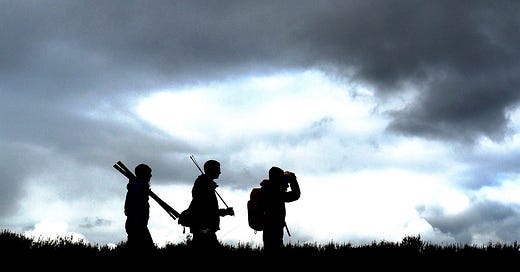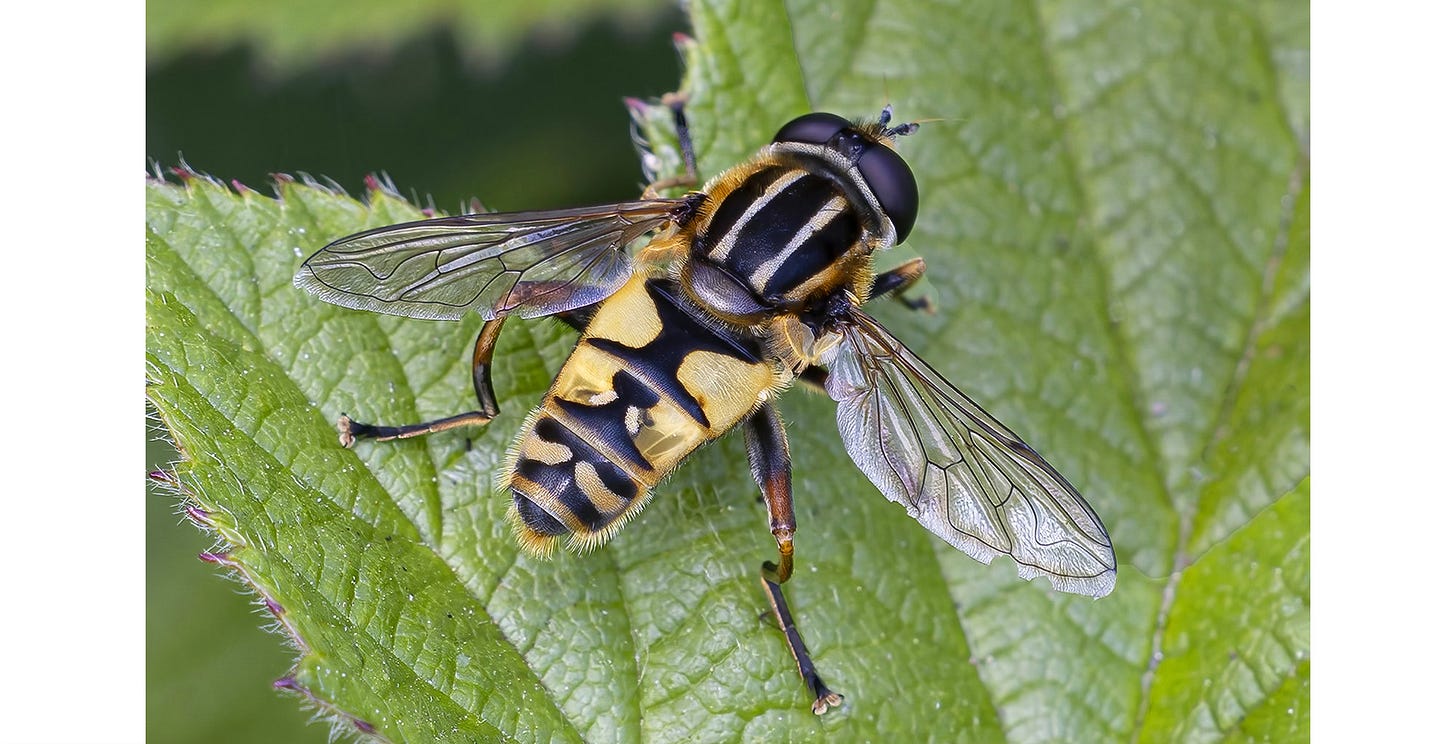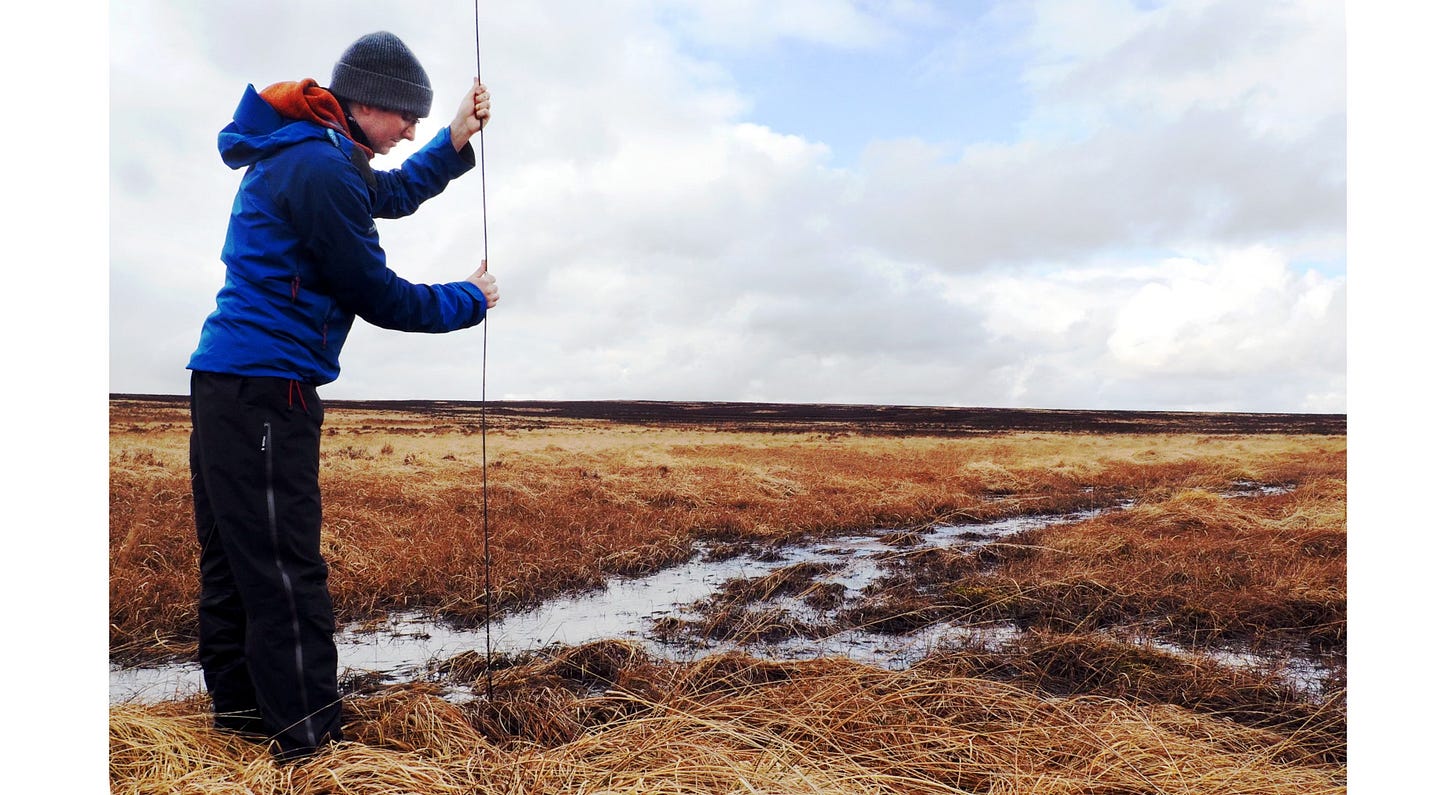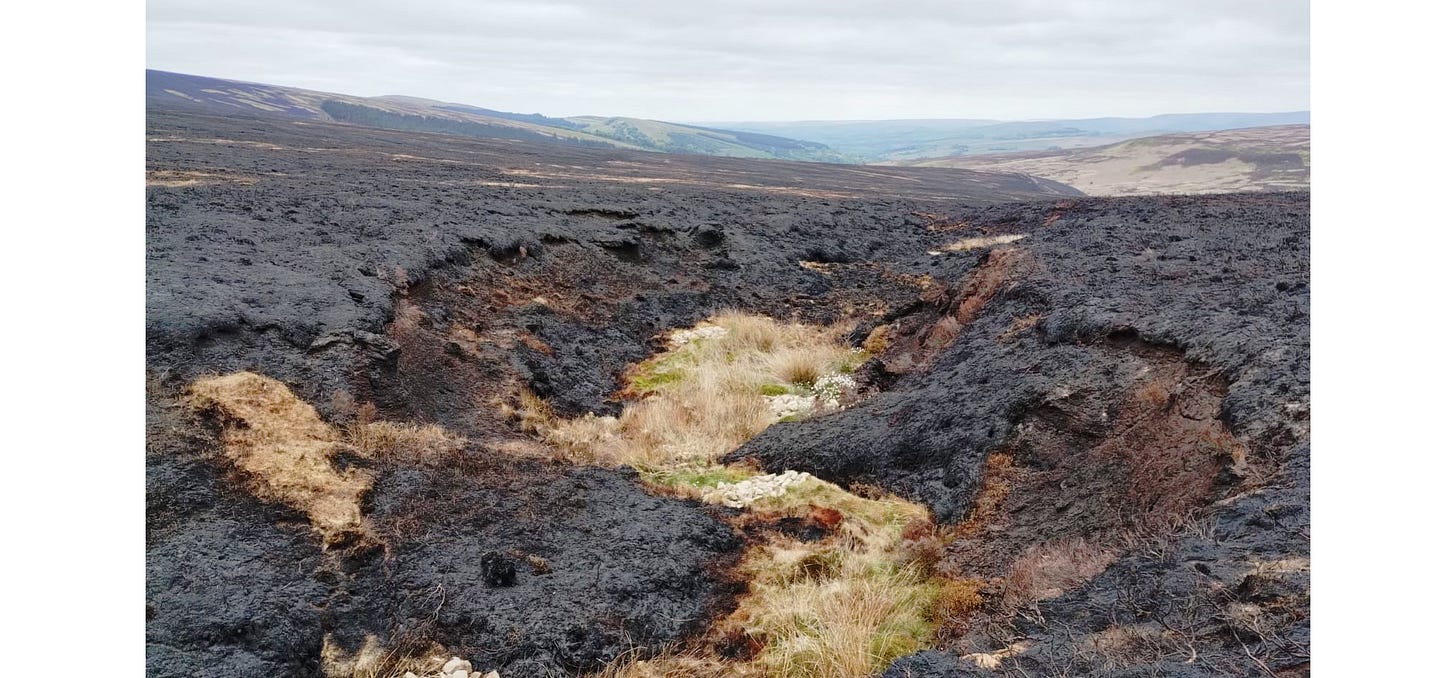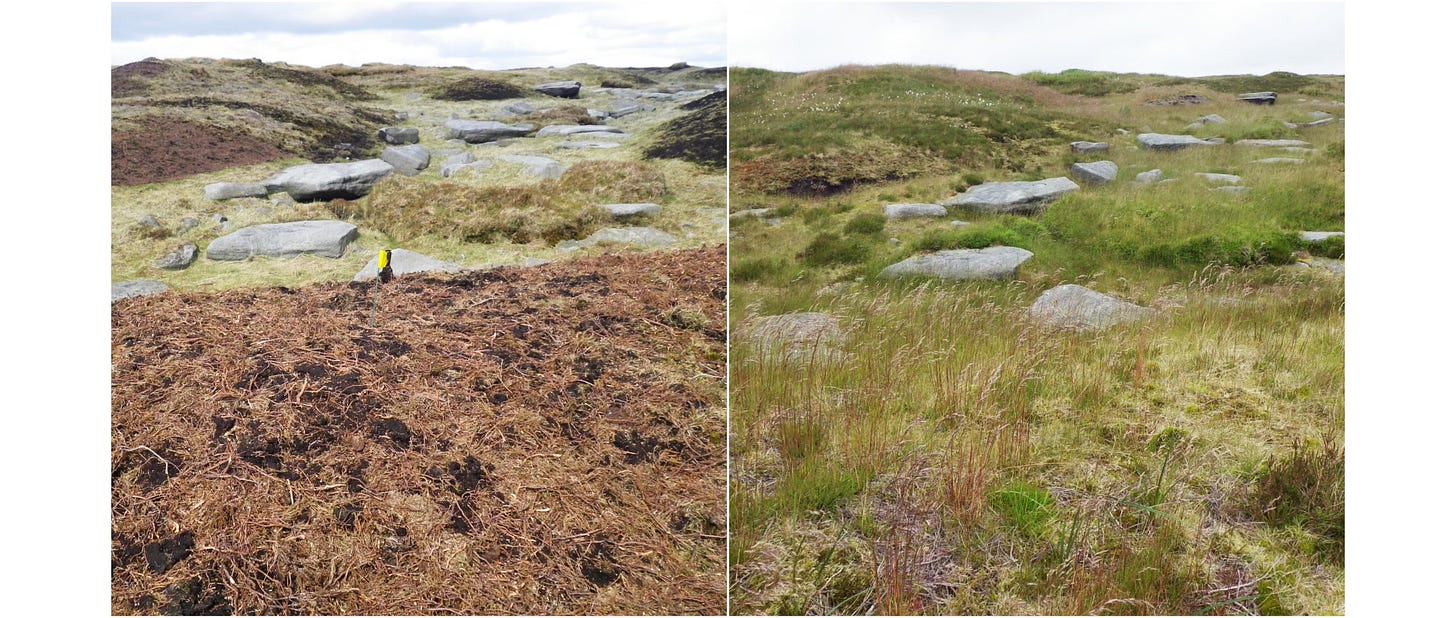Sunday at Bill's Mother's: 29th June 2025
Fire and water. Slower ways to get places. And a return to the hidden hillside.
Morning. Sheffield sits on the edge of a crumbling, incendiary climate emergency. Our moors should be buzzing bogland, humming with life, and sucking carbon into the ground. Polluting chimneys, lame game industries and too many sheep’s teeth and human feet have almost killed our high wetlands over the last two centuries, but now, thanks to a generation of careful science, life is returning, precariously. Today we learn how those scientists are hoping for some steady rain and common sense.
We have an introduction to the Slow Ways movement, and their growing network of take your time and enjoy the journey routes. And we pay another visit to the spectacular hidden hillside in Darnall.
If you like this (or any) post in the vast It’s Looking A Bit Black Over Bill’s Mother’s archive, please share with your mates, because we want all the doers, makers, thinkers, outsiders and deciders of Sheffield to read, comment and join us.
And although every reader is welcome, let’s tip our hat to our 310 lovely full subscribers, because they’re the ones who make all this happen. Once 380 of you have said, yes, I like it, so I’ll dig out a paltry £4 a month to help pay the bills, we’ll be able to cover the costs of this magazine and also provide work for a few freelances too, to get out there and cover even more. You can subscribe for a free trial, or upgrade below.
Hidden Hillside
In any other city, a 70 acre hillside with astounding views and Skylarks overhead would be common knowledge. Here in the Outdoor City, the most common query I’ve had about 70 Acre Hill is: where is it? (Answer: https://what3words.com/clever.lovely.ducks)
Reader and contributor John Scholey got in touch after last week’s introduction with a set of wonderful insect photos taken on his first ever visit. “A very interesting place tucked away where it is,” he said.
Tucked away is right. The simplest approach to 70 Acre Hill is to head through the unlikely industrial estates east of Darnall to the corner of High Hazels Park and Catley Road (https://what3words.com/marked.spared.dared), or skirt the edge via the Transpennine Trail route between Grenoside and Darnall.
Sheffield Museums are currently helping Darnall locals explore the wildlife and countryside on their 70 acre doorstep through one of their Green Connections projects, which may eventually produce films and videos celebrating the site.
“The view from the top is incredible, and it’s in the middle of Darnall,” says Alistair McLean from Sheffield Museums. In the meantime, try the Outdoor City run route or the Ramblers walking route map to make your own explorations.
Bog Building
It’s taken 22 years to work out how to repair two centuries of damage to the country’s biggest carbon store. The solution? Spread a wet green carpet over the top.
The scientists, conservationists and general bog builders from the Moors for the Future Partnership (MFFP) have been watching the moorland round their Edale office turn tinder brown this year, dreading the calls reporting that an overnight fire or barbecue has burned another stretch of moorland back into the black husk of a landscape that had once covered our moors.
That was the standard state of much of Sheffield’s moorland fringe before work began to try and restore the moors of the South Pennines and Peak District.
Now we’ve had a bit of rain here and there, too many people think the moorland fire risk has gone, says Matt Scott-Campbell from MFFP. You don’t have to travel far onto the parched landscape on Sheffield’s borders to see how quickly summer rain showers dry into a desert soil again.
“Some steady rain would be nice,” Matt says. “If we look out from the office and see mizzle, we say: that’s good bog building weather.”
Bogs are beautiful, moorland lovers say. The colours and subtle collections of plants and shimmering bugs and insects are certainly worth your attention, but few of us realise that our upland moors are the “low hanging fruit” of tackling climate change, Matt tells me.
Peatlands are the biggest single store of carbon in the UK, adding up to around 20 years of CO2 emissions from the whole country, at current levels. The Peak District alone has 20 million tonnes of carbon stored in underground peat layers. But that peat, and the carbon within it, is very much at risk.
The scientists and ecologists working on our moors have learned how to restore eroded peat bogs back into a functioning ecosystem, where moorland plants thrive, attracting insects, then birds and bats and frogs and the wild range of creatures you’d meet if you’d wandered around the country’s blanket bogs a few hundred years ago. (Although in a world without mountain rescue, you might not choose to risk it, as a healthy blanket bog might be over four metres deep.)
The degraded South Pennine moonscape some of us remember from the last century was caused by a toxic combination of polluted air and rain from the industrial revolution, overgrazing, periodic fires and thousands of humans expanding the path networks.
In that environment, “sphagnum mosses are absent at scale”, Matt tells me. A wet upland catching rain from the Atlantic should be a mire glistening with miles of tangled mosses. But industrial pollution turned the mire into a wasteland, often as acidic as lemon juice, where sphagnum can’t survive. So the moors crumble and dry, which makes it even harder for sphagnum moss to gain a foothold.
But those mosses, hundreds of species coloured from red and pink to shining green, are the foundation of the nation’s peat stores. (I hope to be chatting to Matt and his team to find out more about the green carpet restoring our moorland in future posts).
The key point is that sphagnum needs rain and wet ground to take hold and grow. So the MFFP technique to restore our moors is patient and painstaking.
You cover the black crumbling peat with heather brash, to stop it eroding and spilling thousands of years of carbon gathered from dead plants into the air and watercourses. You scatter the seeds of moorland plants along with a lime fertiliser and a quick growing nurse crop of bright green grasses (as used on lowland sports fields), which start to knit the soil together so other plants can grow.
The ambitious nurse grasses quickly find they’re in the wrong place and die out, by which time the moorland plants familiar to those hardy wet-footed human explorers of four centuries ago can take hold in a soil no longer so sharply acid, and stitched together by roots of the now ailing nurse grasses.
Gradually, Bilberry, Cloudberry, Cross-leaved Heath and Cotton Grasses return, and rare carnivorous Sundews might appear. You’ll also be building dams and maybe laying heather bales to keep as much rainwater on the tops as you can.
As the ground gets wetter, volunteers and staff working with MFFP and partners like the National Trust add plugs of sphagnum mosses, which all knit together into that green carpet, known as an ‘acrotelm’ says Matt, a 6-10 inch skin on top of the peat that will safely store the carbon of centuries past again.
And now, those mosses and plants are fishing in twenty first century carbon emissions ready to decompose into even more carbon captured for years to come.
Meanwhile, the array of native wetland plants bring in an array of native wetland insects, and all the animals that eat them. “A fully functioning ecosystem like this gives adaptability to climate change,” says Matt. And the tendrils of sphagnum mosses absorb a crazy amount of rainwater, and slow down the rest, so the wet moorland carpet reduces flood risk in the valleys below.
But the buzzing moorland we see in places like the Eastern Moors and parts of Kinder Scout has taken 20 years to get there. And it might take 20 more to become a fully functioning blanket bog again.
All this is in the minds of moorland workers when they get the call about yet another wildfire caused by visitors who may simply see the upland landscape as a great place to haul up the beers and barbies for a summer party.
A moorland that’s begun to breathe and live again will fight off the effects of a fire better than a dry degraded moonscape, but the fire will set the work back years, and someone will need to find another tranche of funding, amounting to tens or hundreds of thousands of pounds, to restart the restoration process again.
Matt and his team are looking out at another hot weekend. “We don’t want to say we want it to rain every day in the summer holidays,” he says.
“But maybe it would be nice if it rained every night when the kids are in bed. And it would be great if more people could see our moors as the ultra high value ecosystems they are, and we enjoy them without damaging them.”
In these days of heatwaves and floods, you’d be rash to say there’s no such thing as bad weather. But on our born again moorlands, there’s no such thing as bad drizzle.
Slow Ways
There’s no need to rush. Many of us learned this a few years ago when the world slowed down for a while to try and fight off a virus. In 2020, the Slow Ways movement began, aiming to map the kind of walking routes you’d be happy to spend hours travelling, between every town and city, and the UK’s national parks and landscapes.
There are now over 85,000 miles of these routes, mapped and tested by volunteers, and the network is planning a huge digital overhaul to produce a resource we can all use to plan our own verified walking or wheeling routes from pretty much anywhere to almost anywhere else. They have a Crowdfunder going to help, but in the meantime you can explore the idea, and plenty of local routes here.
I’ll be finding out more about Slow Ways around Sheffield for a future post.
More What’s On Out There (from Sunday 29th June)
A tiny selection from our new (and regularly updated) What’s On Out There news and listings post for June and beyond.
Sun 29th - SRWT Events- Woodhouse Washlands bird walk
Mon 30th - Fri 4th July - Daily health walks in parks and green spaces from Step Out Sheffield, 10 am start
Tues 1st - Friends of Ecclesall Woods volunteer & footpath repair session
Weds 2nd - Shire Brook Valley - Volunteer Session
Thurs 3rd - Graves Park Climate Resilience Project: Bird & Meadow Walks
Fri 4th / Sat 5th - SRWT Events- Moth Trapping at Greno Woods (£10)
Sat 5th July - Inaugural Coal Aston Gala Chase - (£8/10)
Sat 5th - Friends of Whirlow Brook Park volunteer session
Reader-support is the only way to make local journalism happen. Feel free to take out a free trial for a few weeks if you’ve not been here before, to see if you like us. And if you do, you can make my Sunday by joining our unique publishing social enterprise below, for the monthly cost of a Millhouses flat white.

